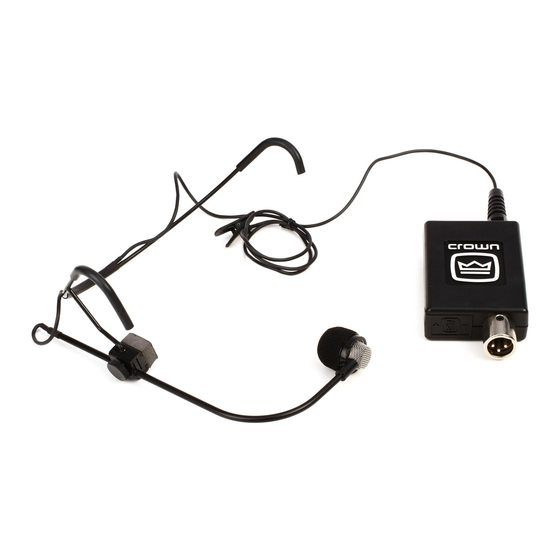Crown DIFFEROID CM-311A Manual Aplikasi - Halaman 4
Jelajahi secara online atau unduh pdf Manual Aplikasi untuk Penguat Crown DIFFEROID CM-311A. Crown DIFFEROID CM-311A 14 halaman. Differoid head-worn condenser microphone
Juga untuk Crown DIFFEROID CM-311A: Lembar data (2 halaman), Panduan Tambahan (1 halaman), Manual Aplikasi (6 halaman), Panduan Ikhtisar (1 halaman), Bagaimana cara menggunakan (4 halaman), Panduan Cepat (2 halaman)

How to reduce background noise
• Stop the noise at its source: turn off appliances and
air conditioning; wait for airplanes to pass; close and
seal doors and windows; use a quiet room.
• Mike close with directional mics.
• Pick up electric instruments with direct boxes or
cables.
• Aim the null of the polar pattern at the offending
noise source. The null is the angle off-axis where the
mic is least sensitive. Different polar patterns have
nulls at different angles. Shown below (Figure 1) are
the null angles for various polar patterns:
Cardioid
Supercardioid
Hypercardioid
Bidirectional
How to reduce leakage
Leakage (also called bleed or spill) is the overlap of
sound from an instrument into another instrument's
microphone. For example, if you're miking drums and
piano each with it's own microphone, any drum
sound picked up by the piano mic is leakage. To
reduce leakage:
• Mike close with directional microphones.
• When recording, overdub instruments one at a time
on each track of a multitrack recorder.
• Pick up electric instruments with direct boxes or
cables.
• Use a room or studio with dead acoustics. The walls,
ceiling, and floor should be covered with sound
absorbing material.
• Aim the null of the polar pattern at the undesired
sound source. For example, suppose you're miking
two adjacent tom-toms with two hypercardioid
mics. The null of the hypercardioid is 110 degrees
off-axis. Angle each mic so that its null aims at the
adjacent tom-tom.
• Use a Differioid mic on vocals such as the Crown
CM-310A or CM-311A.
180 degrees
125 degrees
110 degrees
90 degrees
How to pick up sound at a distance
The farther you place a microphone from a sound
source, the more reverberation, leakage, and back-
ground noise you pick up. Also, you hear more mixer
noise compared to the signal because the mixer gain
must be higher with distant miking.
To clearly pick up sound at a distance:
• Use a microphone with low self-noise (say, less
than 22 dB SPL), such as the CM-200A, CM-700,
CM-150, any PCC, or any PZM® (see the Crown
Boundary Mic Application Guide).
• Boost the presence range on your mixer's EQ
(around 5 kHz).
• If necessary, compensate for air losses at high
frequencies by boosting EQ around 15 kHz.
• Use directional microphones. You can place a
directional mic farther from its source than an
omnidirectional mic and pick up the same amount
of reverberation. The table below shows the distance
multiplier for each pattern (Figure 2):
Omnidirectional
Cardioid
Bidirectional
Supercardioid
Hypercardioid
Cardioid
Supercardoid
Hypercardoid
Shotgun
For example, if an omni mic is 1 foot from a sound
source, you can place a supercardioid mic at 1.9 feet
and pick up the same amount of reverb as the omni.
4
1.0 dB
1.7 dB
1.7 dB
1.9 dB
2.0 dB
A = 1.7
A = 1.9
A = 2
B = 3 to 10
depending on length
